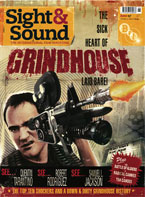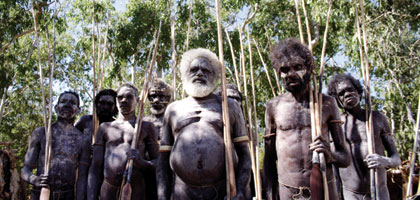
Ten Canoes
Australia 2006

Reviewed by Adrian Martin
Synopsis
Our synopses give away the plot in full, including surprise twists.
Arnhem land, Australian Northern Territory. In voiceover, 'the Storyteller' introduces the history and mythology of his Yolngu people. We then enter the tale of Minygululu, an elder of the tribe, who leads a group of ten men into the forest to harvest bark for canoe-making and to gather goose eggs. Minygululu realises that young Dayindi lusts after his third and youngest wife. As this is a potential trespass of tribal law, Minygululu decides to take the matter in hand by telling Dayindi, as they work side by side, a complex story from "a long, long time ago". In this embedded tale, Ridjimiraril has three wives, Banalandju, Nowalingu and Munandjarra. Ridjimiraril's younger brother, Yeeralparil, longs to be with Munandjarra. One day, a stranger approaches the camp. When Nowalingu vanishes suddenly, Ridjimiraril is certain that the stranger has taken her. Months later, when Nowalingu is reported as having been seen in a distant camp, the men set off in a war party. They find nothing, but an increasingly depressed Ridjimiraril, aided by Birrinbirrin, later takes the opportunity to spear a person he thinks is the stranger. However, they kill the wrong man. Yeeralparil volunteers to be Ridjimiraril's partner in facing the spears of the man's aggrieved tribe. Ridjimiraril is wounded and eventually dies. Yeeralparil becomes the new husband to his brother's three wives; Nowalingu returns and tells her surprising tale of captivity; and Birrinbirrin calls an end to the cycle of warlike behaviour. Back with Minygululu, as work ends, the tale has had its desired effect on Dayindi.
Review
Hollywood script gurus currently preach the importance of something they call, in ominous tones, 'story'; but no film in recent memory is as fixed on the process of storytelling as the remarkable Ten Canoes. In this Aboriginal tale, the Storyteller speaks of the need to 'find' the story, which arises from the land as the Yolngu people themselves do; and, once found, it must be respected and patiently followed, left to grow like a tree, and allowed to resolve itself in its own good time. Everything follows the staggered, drawn-out rhythm of what the film calls, and not frivolously, a 'good story': work, understanding, interrelationships. As well as the stories nested within stories, there are also, along the way, unusual 'speculative' scenes that visualise incidents that might or could happen - and these are the funniest of the lot.
The film itself has a tree-like structure. As conjured by the Storyteller, it "begins in the beginning", like the 'Dawn of Man' sequence in 2001: A Space Odyssey - but with an altogether less sententious tone, and indeed with a Star Wars gag ("Once upon a time, in a land far, far away..."). This section is in colour; when the story of Minygululu and Dayindi begins, the film shifts into black and white. But the next shift is less conventional: once Minygululu begins to relate the tale of Ridjimiraril and Yeeralparil (situated "after the beginning, but a long, long time ago"), the film returns to colour. Ultimately, the effect of all this shifting, and these stories within stories, is to vividly communicate a theme of transmission: as long as a story is being passed on, as long as it is growing and being revived by new tellers, it is not a thing of the past but part of a living heritage.
The success of Ten Canoes in Australia rewrote several hitherto ironclad suppositions of the local film industry. Rolf de Heer showed that it was possible, by careful and sympathetic collaboration with co-director Peter Djigirr and all the indigenous participants, to make a film that was not condescending, exploitative or misrepresentative. He also proved that the general audience could take a film spoken largely in the Aboriginal dialect of Ganalbingu, with English subtitles. (The splendid DVD edition offers variant versions with the voiceover narration also in Ganalbingu, and no English subtitles at all.) Despite some grumblings in the conservative press - one tub-thumping columnist complained that no taxpayer should have to endure an arty local production that is plotless, in black and white and subtitled, thus revealing he had not seen it - audiences realised they were seeing something that marked a quantum leap beyond such well-meaning but limited 'whitefella' depictions of Aboriginal life as Bruce Beresford's The Fringe Dwellers (1986) and Phillip Noyce's Rabbit-Proof Fence (2002).
The film's tone largely clinches its power of persuasion. Many Australian viewers and reviewers were disarmed by its proudly 'low' humour: jokes abound about shitting and prick size, overeating men and chattering women. Indeed, on this level, Ten Canoes pulls off a rare feat: it skirts political incorrectness in its play with stereotypes, but ends up being a politically correct winner, in the positive sense of pleasing every viewer and offending none, whether black or white - and hence contributing, in a more subtle manner than contemporary Australian cinema is known for, to the racial 'reconciliation' that remains a hot topic of public discourse.
This could not be more different to de Heer's previous film on an indigenous subject, The Tracker (2002), a minimalist, Western-like historical parable which gleefully condoned the 'revenge killing' by blacks of the whites who oppressed them, thus dividing its audiences right down the middle. The distance between the two films can be measured by their use of a true Australian star, David Gulpilil - from playing the brutally victimised but wily tracker, he here becomes the voice of the Storyteller, with a range of vocalisations and inflections, and a magician-like ability to conjure narrative, that would make Orson Welles proud.
In The Tracker, and indeed most of his films since the 80s, de Heer reinvented stylistic devices from early cinema (his latest, Dr Plonk, is a comic pastiche of silent films), above all a certain disconcertingly direct, 'presentational' mode of shooting. This has, at times, led him into a clunky kind of 'naive art' manner, usually allied with the onscreen viewpoint of a child (The Quiet Room, 1996), alien (Epsilon, 1997), deranged outsider (Bad Boy Bubby, 1993) or disabled person (Dance Me to My Song, 1998). In Ten Canoes, de Heer refines his wilfully naive style in a pleasing way: the film makes much of the frontal 'portrait shots' that introduce characters, or the way that characters 'parade' in a file before the camera, as in some ancient actuality footage. Thanks to cinematographer Ian Jones and sound designer James Currie, however, more subtle and intricate textures are also explored: dramatic moments seem to set off disturbances in the natural world itself, its light and ambient sound. Such exquisite effects draw Ten Canoes close to Terrence Malick's The New World - in form as well as in content.
Credits
- Directed by
- Rolf de Heer
- Co-directed by
- Peter Djigirr
- Produced by
- Rolf de HeerJulie Ryan
- Written by
- Rolf de Heer
- in consultation with the people of Ramingining
- Inspired by the photographs of
- Dr Donald Thomson
- Director of Photography
- Ian Jones
- Film Editor
- Tania Nehme
- Art Director
- Beverley Freeman
